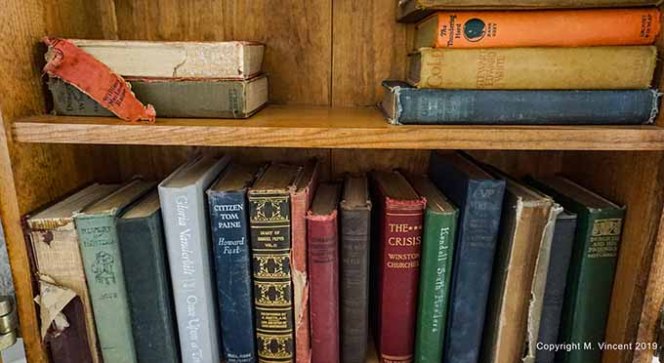
It’s National Library Week in the United States, and I’m pleased to join the celebration by sharing a part of our library history I recently discovered on a visit to the Heceta Head Lighthouse near Florence, Oregon.
That’s the lighthouse pictured above, viewed from a highway lookout point. While easily accessible by car today, you can imagine its remoteness from the time it began operation in 1894 to the time modern transportation and technology made it no longer a solitary outpost inhabited by hardworking lighthouse keepers and their families.
Many U.S. lighthouses were similarly isolated, with difficult access to the outside world and few options for leisure and entertainment. For lighthouse keepers and their spouses life was constant work — a serious, often monotonous regime of maintenance, watching for something to happen, and meticulously recording events.
Heceta Head light and its surroundings are striking. Some say it’s the most photographed lighthouse in the U.S., and I was lucky to capture it on a bright sunny day in a week of rain. Here is a closeup among the trees:

When I’d taken full advantage of the photo opportunities and needed a break from the brisk sea wind, I took shelter in a small building with various lighthouse history exhibits. A set of books in a hinged wooden case labeled “Replica Lighthouse Library Box” caught my attention, and I learned about a special library system I’d never come across before.
Circulating Libraries Created for Lighthouse Keepers
Small portable libraries like the one below in the Heceta exhibit were distributed to lighthouses across the U.S. in the 19th century. Used to improve morale at solitary stations, they became an important part of life for keepers and their families.

As Natalie Zarrelli speculates in an article for Atlas Obscura (cited with link below), one of these sturdy wooden boxes filled with books was “possibly the most awaited item” when a boat arrived with a shipment of supplies. Her article tells us the boxes were made of thick, heavy wood and, as you can see in the exhibit, did double duty as carrying cases and bookshelves.
Each library box could hold 50–60 books. The contents varied with a box’s origin. At least some of the books were bought or donated by private groups.
The Heceta exhibit indicates the steady growth of these mini libraries: In 1876, 50 were created. By 1885, more than 400 were in circulation, with 40–60 volumes each. By 1893, over 700 boxes were in transit along U.S. coastlines, delivering much-appreciated reading material to lighthouse families.
Per the exhibit, the libraries moved from station to station via lighthouse inspectors who exchanged the boxes during quarterly inspections. According to Zarrelli, these district inspectors coordinated among themselves which library went to whom. As they swapped one library for another, the libraries traveled the entire circuit of U.S. lighthouses.
How Did These Lighthouse Libraries Arise?
Clearly, lighthouses and their keepers were crucial to safe navigation, and keeping them both in good condition was important. Accordingly, in the mid 19th century, the United States Lighthouse Board (USLB), the federal agency responsible for lighthouse construction and maintenance, began improvements to stations around the country.
Along with changes like new, more powerful Fresnel lenses and fresh paint, came amusements to help lighthouse keepers handle the monotony and isolation of the job. Most significant were the traveling libraries which appeared around 1876.
By then, portable libraries for naval and merchant ships had existed for decades. A religious organization –– the American Seamen’s Friend Society –– provided many library cases for Navy vessels, and they worked with the USLB to bring books to lighthouse keepers as well.
The End of the Journey
The lighthouse libraries were widely used until the radio, telephone and improved transportation made them less important. Most were phased out by the 1920s as the stations became automated.
What special or unusual libraries have you discovered? Please share one of your favorites.

References and Resources
Zarrelli, Natalie (2016, February 18). “The Most Precious Cargo for Lighthouses Across America Was a Traveling Library.” Retrieved on April 11, 2019 from: https://www.atlasobscura.com/articles/the-most-precious-cargo-for-lighthouses-across-america-was-a-traveling-library
Zarrelli’s article provided much useful background for this post.
Heceta Lighthouse and Bed & Breakfast: https://www.hecetalighthouse.com/
Copyright M. Vincent 2019. All photos copyright M. Vincent 2019.

Thank you for this well-told story. I visited Heceta Head, went into that same building with the exhibits, and entirely missed the information about the library. You get credit for being an attentive traveler, as well as an excellent writer and photographer.
LikeLiked by 1 person
Thanks for the compliment. I was delighted to discover this bit of library history, and I’m glad you enjoyed the story. I can imagine the excitement at Heceta when a new library box arrived.
LikeLiked by 1 person
Such a fascinating post. Thank you!
LikeLiked by 1 person
My pleasure. By the way, I very much enjoy your posts. Happy travels, including library discoveries!
LikeLiked by 1 person
Thank you!
LikeLike
Amazing! I never knew. Prettiest library and lighthouse I’ve ever seen. Thanks.
LikeLike
Thank you for commenting. It’s truly a spectacular place with lots of fascinating history.
LikeLike
Great post and fantastic photos, that’s a very pretty lighthouse and such a lovely story
LikeLiked by 1 person
Thank you. So glad you enjoyed the post. The coastal setting is striking, and the lighthouse has so much interesting history. It was a delight to visit and photograph.
LikeLiked by 1 person
The International Seaman’s Center in Houston still provides book collections to the various merchant vessels that come through the port here. I didn’t realize that the practice had such a long history; interesting that both lighthouse keepers and sailors at sea shared the isolation that made the books so important.
When I lived in Liberia, Peace Corps volunteers and expats around West Africa had a similar system. It was informal, of course, but quite functional. As a matter of fact, I was introduced to Durrell’s Alexandria Quartet in Freetown, thanks to a copy of Balthazar dug out of just such a box.
LikeLiked by 1 person
Thank you for commenting. It’s interesting to know that these seagoing libraries still exist on merchant ships. That made me curious about the U.S. Navy, and I found that its Morale, Welfare and Recreation program includes “afloat libraries.” NAVSEA command funds an initial library for every new ship and submarine. Laptops, DVDs and such now appear among the books and magazines.
I love hearing about the special, informal little libraries like your Peace Corps-expat system. Ah, the Alexandria Quartet! Nice find. I devoured those books in quick succession in my 20s after finding Justine.
LikeLiked by 1 person
Hi,
Fascinating post! I’m the editor of the ALA Library History Round Table’s blog, LHRT News & Notes: https://lhrtnews.wordpress.com/library-history-news/
Would it be OK if I posted a link back to your post in our news section?
LikeLike
Thank you, and yes, it would be fine to post a link. I’m delighted to hear from you and learn about the LHRT. I’m an enthusiastic fan of libraries and their history and look forward to perusing your posts and articles.
LikeLike